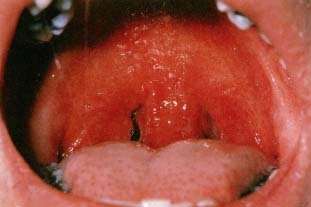Strep Throat

Strep throat, an infection of the throat common in children, is caused by bacteria in the Streptococcus (strepto-KOK-us) family. Its main symptoms are sore throat and fever. The medical term for strep throat is streptococcal pharyngitis (fa-rin-JY-tis).
KEYWORDS
for searching the internet and other reference sources
Infectious diseases
Streptococcal pharyngitis
What Are the Symptoms of Strep Throat?
In addition to having a sore throat and fever, people with strep throat feel generally weak and tired. They may also have a runny nose, have a headache, or the lymph nodes * in their neck may become enlarged. In some cases, toxins (poisons) from streptococcal bacteria may lead to a red, sandpapery rash, which is called scarlet fever.
How Are Strep Throat Bacteria Transmitted?
Children between the ages of 5 and 15 are most at risk for streptococcal infections, although they can occur in people of any age. If children who have strep throat sneeze or cough in a classroom, playground, or other crowded environment, they can spread the infection to the other people. Moisture droplets from their coughing or sneezing are passed into the air. Other children inhale these germs, and then they too become infected. Within 2 to 4 days they may begin to show symptoms.
* lymph nodes are bean-sized round or oval masses of immune system tissue that filter bodily fluids before they enter the blood-stream, helping to keep out bacteria and other undesirable substances.
Another way the bacteria can be passed along is by hand to hand contact or by touching objects that an infected person has recently handled. That is why doctors tell people to wash their hands often.
How Do Streptococcus Bacteria Operate in the Body?
Streptococci (strepto-KOK-sigh) are round bacteria. They grow like beads on a string. These bacteria are responsible for many different types of diseases. Certain types of Streptococci are harmless. They remain in the mouth and throat where they do no damage. If they should enter the bloodstream they usually are killed quickly by the body's natural defense systems.

If the same Streptococci reach the heart, however, they may be able to survive there and can later cause heart damage. Bacteria that make it to the urinary system can cause urinary tract infections.
If a streptococcal infection does not go away on its own or respond to treatment, there are a number of possible serious complications. These include:
- Nephritis (nef-RY-tis), an inflammation of the kidneys
- Rheumatic fever, a condition involving the heart, joints and other parts of the body, which can cause permanent damage to heart valves
- Deeper tissue infections that spread from the original infection
How Is Strep Throat Diagnosed and Treated?
A doctor who suspects strep throat will have to take a throat culture before the diagnosis can be confirmed. This is done by touching a swab to the back of the person's throat to pick up a sample of bacteria. The bacteria can be grown in a laboratory dish overnight and then identified under a microscope. Alternately, "instant" tests exist that can tell almost immediately if strep bacteria were picked up on the swab.
The antibiotic * penicillin (pen-i-SIL-in) is freqently prescribed to treat the infection. If the patient is allergic to penicillin, then another antibiotic is used. Usually the infection will clear up within a week after treatment has begun.
* antibiotics (an-ty-by-OT-iks) are drugs that kill bacteria.
Resources
Organization
The National Institute of Allergy and Infectious Diseases posts
information on strep throat on its website.
http://www.niaid.nih.gov/factsheets/strep.htm
Comment about this article, ask questions, or add new information about this topic: